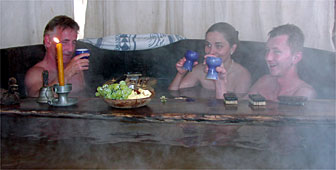Frozen ghosts haunt Gemmi Pass

They came, they saw and they crossed the Gemmi Pass, but none of the many famous 19th century writers who wrote about it conquered the route in mid-winter.
The local authorities now keep the pass open at this time of year, which enabled swissinfo to follow in the footsteps of many a literary giant.
The Gemmi Pass, which links the Bernese Oberland with canton Valais, was one of the most frequented north-south mountain routes for writers, artists and scientists exploring the Alps.
Many stayed at the Schwarenbach Inn, located halfway across the pass.
“Here’s Jules Verne, dated 1873,” says innkeeper Peter Stoller as he opens a couple of old leather-bound guest books, heavy with history.
Another volume preserves the signatures of Picasso and friends who made the crossing in 1933.
A tramp on the Gemmi
Mark Twain’s entry is suspiciously missing, but he immortalised the pass and its inn in a book about his European travels.
The lodge sat “on a lonely spot among the peaks”, he wrote in “A Tramp Abroad”, “where it’s swept by the trailing fringes of the cloud rack and is rained on and snowed on and pelted and persecuted by the storms nearly every day of its life”.
The inn can even be “snowed on” in mid-summer, says Stoller as he heads outside to scrape, dig and shovel a thick layer of snow and ice away from the front entrance.
Perhaps it was the raw climate that inspired other writers to set tales of murder and intrigue at the Schwarenbach.
Den of thieves
By the time of Twain’s visit, the Schwarenbach had already gained a reputation as a den of thieves and murderers.
“February 24” by the German writer, Zacharias Werner, tells the gruesome story of a family of innkeepers torn apart by tragic circumstances.
A man kills his father, his son kills his sister and finally the father murders the son.
The French author Guy de Maupassant set his own chilling story of suspense and horror in the Schwarenbach, and the avid mountain hiker, Sir Arthur Conan Doyle, thought it suitable for a scene in a Sherlock Holmes novel.
Avalanches
“The real winter dangers on the Gemmi are avalanches,” says retired pastor Ueli Junger from the village of Kandersteg, on the north side of the pass.
“Just before one climbs up from Kandersteg to the Schwarenbach Inn, there’s a narrow gate with a steep rocky slope on the east side and the snow doesn’t hold long on the rocks there,” explains Junger.
The man who has become Kandersteg’s unofficial historian shrugs off the inn’s reputation as a den of thieves and murderers as “propaganda, because one likes to visit places shrouded in mystery”.
Once a week, Junger leads walking tours of Kandersteg which end with a visit to the old parish church.
But instead of preaching the gospel as he once did, Junger stands at the pulpit and enlightens a small group of German and British tourists on the history of the Gemmi Pass and its legends.
Stale alpine air
In the early 18th century, as Junger explains, doctors warned that people could contract disease from the stale alpine air.
Why else, they asked, were mountain people so sickly? That all changed later in the same century when the pioneering Swiss scientist, Albrecht von Haller, crossed the pass and discovered a happy, and anything but sickly, mountain people.
“Von Haller was impressed by the health of the people in Kandersteg,” Junger continues.
“He wrote a poem describing them as poor but with the ability to laugh despite their poverty, so the alpine environment was seen as contributing to their well-being,” he adds.
“This gave the initial impetus for tourism because for the first time people crossed mountain passes not because they had to in order to conduct trade, but because they simply wanted to experience the mountains.”
swissinfo, Dale Bechtel on the Gemmi Pass
The trail from Kandersteg over the Gemmi Pass to Leukerbad is 12 km long, and takes approximately 3 hours with the use of the gondolas at each end.
The trail begins at the upper Sunnbüel station at 1,920m, and rises to 2,314m at the southern end.
The Schwarenbach hotel is open from February to the end of October.
The Gemmi Pass was a key north-south alpine route before the advent of the railway.
Many illustrious 19th century authors immortalised the pass in their writings.
The pass is now open to hikers in winter, and is one of dozens of winter trails in the Swiss Alps (see “related site”).
One of the most legendary figures to have graced the Gemmi Pass and its inn was not a person but the innkeeper’s cat, Tomba. In the1980s, it accompanied climbers on dozens of ascents of surrounding peaks.

In compliance with the JTI standards
More: SWI swissinfo.ch certified by the Journalism Trust Initiative


You can find an overview of ongoing debates with our journalists here. Please join us!
If you want to start a conversation about a topic raised in this article or want to report factual errors, email us at english@swissinfo.ch.